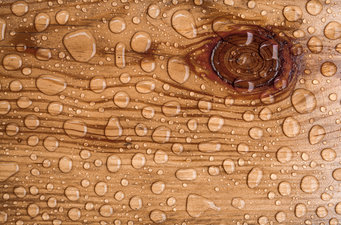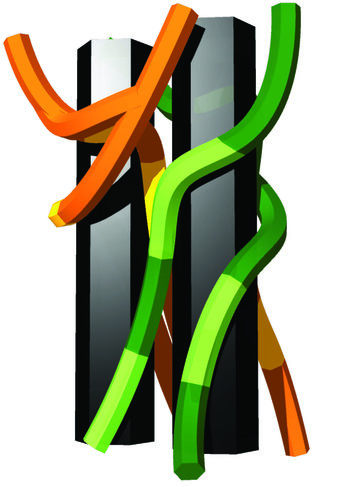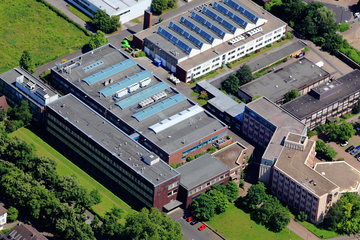Wood and the influence of water
A model describing the water absorption of wood could contribute to the development of new wood preservatives
The cell walls of wood are its muscles and the amount of water they absorb changes how the wood behaves: which forces it exerts and withstands and how it sheds the seeds of fir and pine cones, for instance. Scientists from the Max Planck Institute of Colloids and Interfaces in Potsdam, the Institute for Separation Chemistry in Marcoule (ICSM) and the University of Montpellier are using a new mathematical model to illustrate how the water content of the cell walls determines the properties of wood. The formula will improve our understanding of how wood acquires its mechanical properties, but could also be useful for developing non-toxic wood preservatives.

The same properties that give wood its elasticity and hardness also swiftly render it unfit as a material. When there is no bark to protect it, wood becomes an easy prey for fungi as soon as it absorbs water. This is why Roman boat builders used to douse their hulls with tar pitch in ancient times to waterproof their boats. The last 300 years saw the use of creosote, which is distilled from coal tar, become the primary choice of craftspeople when it comes to preparing the natural material for outdoor use. However, as these substances are among the most carcinogenic known, public health authorities in many countries have largely banned their use.
Scientists are therefore looking for alternative combined impregnation solutions to provide the same protection for wood. “Our model should help them in this search,” says Luca Bertinetti, a scientist at the Max Planck Institute of Colloids and Interfaces. The model describes how much water is stored by wood cells, or rather, their walls. It can also predict how a substance used to treat wood will affect its water absorption. This means that scientists could start designing new treatments without having to perform a lot of systematic experiments.
The model provides an overview of the dominant forces

When developing the model, the scientists first studied the structure of wood cell walls and how this changes when it absorbs water. The cell wall is a natural composite consisting of different biological polymers, i.e. chain molecules. It is partly made up of cellulose fibres aligned in parallel. In a dry state, they make up half of the mass. Hemicellulose and lignin fibres fill the spaces around the cellulose. Both chain molecules chemically interact with cellulose in many places. Hemicellulose and lignin fibres store the water absorbed by the cell wall, much like a sponge. The mix of the two constituents swells and expands the cellulose bundles. Bertinetti explains: “How much water the cell wall can absorb mainly depends on the forces at work.” That is why he and his colleagues have included an overview of the dominant forces in their model.
The most important force is hydration swelling at nano-scale: It pushes the cellulose fibres apart because the water molecules tend to orient at the interfaces with the hygroscopic cellulose and hemicelluloses and this generates suction. The wood cell wall also tends to absorb ambient humidity because of the increased entropy. In simple terms, entropy can be imagined as a measure of the degree of disorder in the system. The order of different biopolymers in the wood cell wall is somewhat disturbed when water penetrates the network. This promotes the swelling process because nature has an inherent tendency toward greater disorder – something that can be observed in a child’s room that is not tidied regularly.
The effect of different forces on swelling
There are, however, forces that suppress swelling. These were also taken into account by Bertinetti and his colleagues when developing the formula. For instance, the force that is exerted through the bonds between cellulose on the one hand, and hemicellulose and lignin on the other hand. They tie the crystalline cellulose bundles together, making it more difficult for water to penetrate them. The elasticity of the biological composite behaves similarly. It acts pulling together the network of the different polymers once it is swollen.
“In contrast to earlier models of the water absorption of wood, our model also takes into account not only the chemical and molecular forces, but also the colloidal forces at meso-scale and finally mechanic term, i.e. elasticity,” says Bertinetti. This is precisely the advantage that scientists seeking to develop new wood preservatives will gain with the new model: for the first time, an overview of all the significant forces in water absorption is available. “Wood engineers will be able to compute how, modifying each of the contributions, will affect the swelling of the wood,” explains Bertinetti. Thanks to the model, they will be able to estimate how much water wood will absorb, for instance, if they reduce the hydration force, which can be decreased using hydrophobic substances on the cellulose or hemicellulose. The model also shows the effect of increasing the cross-linking of the different constituents. “Up until now, wood engineers had to use trial and error to determine how different wood preservatives influenced water absorption,” says Bertinetti.
Biological motors may be able to use the water absorption of wood
The theoretical framework is useful both to scientists looking for wood treatments minimizing the swelling as well as to those interested in maximising it. When exposed to the force of water, the material stores energy which it can convert into mechanical work. According to Bertinetti, “it may be possible to construct actuators based on natural tissues that work according to this principle.” Such “motors” could potentially use the difference in humidity between day and night to, for instance, automatically open and close awnings.
However, that is not the job of Bertinetti. “I’m not an engineer,” he says. The chemist is now working in a different direction with his model for the moisture absorbency of wood. He wants to adapt it to other natural tissues, the swelling of which can be significant for biological and technical processes. He has already made a big step in understanding with the model developed for wood, as it contains all the major factors that will be crucial in other tissues.
KE/PH













